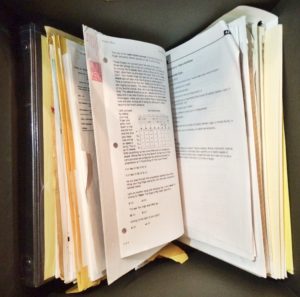Sometimes students come across our path who are late to class, missing materials, and disorganized. They cannot seem to plan their assignments and they turn their work in late. These experiences can be frustrating to teachers, but it is important to remember that they can be frustrating to the students, too! There is a cause for these behaviors. In some cases, the cause is executive functioning (EF) issues.
Planning and Organization: An Executive Function

Papers in a box, to be filed later
Executive functioning is defined as “the mental processes that serve a supervisory role in thinking and behavior. It incorporates a number of neurologically based operations that work together to direct and coordinate our efforts to achieve a goal.” (Cooper-Kahn & Foster, 2013, p. 7).
Executive functioning includes eight core executive skills, one of which is planning and organization (Goia, Isquith, Guy, & Kenworthy, 2000). Students with Autism Spectrum Disorder (ASD) and nonverbal learning disability (NLD) can be significantly impacted in the skill of planning and organization (Semrud-Clikeman, Fine, & Bedsoe, 2013).
Planning and organization is “the ability to impose order on thoughts, tasks, play, and storage spaces,” (Cooper-Kahn, & Foster, 2013, p. 10). Students with poor planning and organization skills have difficulty breaking larger goals into smaller tasks. They also struggle to organize thoughts into a hierarchy. Their brain has a figurative filing cabinet, but they “just open the drawers and throw things in,” (p. 10). Organization of physical papers can be just as challenging.

A person with planning and organization difficulties may just open the drawer and throw the papers in there.
Consider your student who has a disorganized backpack with everything dumped into the main compartment. Call to mind the student who cannot remember to sign up to give a speech in class, despite your many reminders. Think about the student who rattles off information that doesn’t seem to you to connect to anything else that has been said in class. Those students may have issues with planning and organization.
Learning Skills Through Games
Digital technologies now permeate most areas of our lives. They are readily available at school and at home. We only need to look around at parks, restaurants, and grocery stores to see how widely available they are. Used wisely, technology can be a tool for helping students with learning needs including planning and organization.
Students can learn skills and techniques for planning through digital games like strategy games, simulation games, and role-playing games. In these games, they learn skills such as predicting game events and switching between short- and long-term goals. They learn to prepare for an event by stocking up items in inventory, and they learn from their mistakes (Kulman, 2014).

Games like Minecraft help students develop planning and organization skills. Screenshot by Aidan Van Loo
Games like Minecraft, Scratch, and LittleBIGPlanet help to support planning skills through fun and interactive means. Students need “foresight, planning, dividing the plan into steps, and then actually producing the work,” (Kulman, 2014, p. 118) to be successful.
App Recommendations for the School Setting
In addition to games, there are apps that can be both fun and helpful for students who need support with planning and organization. There is a direct application in the school setting as these tools can support students with the business of doing school.
Students learn planning skills through apps when they use productivity tools to set and prioritize goals and when they search through digital content using keywords (Kulman, 2014).
Two apps that support those skills are Evernote and Wunderlist. They are both powerful apps and are both on my list of regularly used tech tools for school. Either one could provide substantial support for a student. Used together, they can help students plan and prioritize commitments and organize and archive information.
Evernote provides the ability to capture lists, notes, photographs, drawings, and websites. Evernote also has excellent capabilities for archiving information. Because it is searchable, anything that is archived in Evernote can be found again.
Wunderlist is also a powerful list-making tool. The beauty of Wunderlist is that it is possible to prioritize list items with due dates, and to include subitems for each list item. Also, Wunderlist can push notifications to the students, so students who have a difficult time remembering to check a list will be automatically reminded.
With both tools, students are able to make notes and write lists in advance of a project due date. Both tools allow sharing of notes or lists with others. Both tools are available online and as a download to the student’s device. If a student discovers that an Evernote checklist would make more sense as a Wunderlist, it is easy to use Evernote Integration via Task Clone to move that list from one app to the other.
References
Cooper-Kahn, J., & Foster, M. (2013). Boosting executive skills in the classroom: A practical guide for educators. San Francisco, CA: Jossey-Bass.
Gioia, G. A., Isquith, P. K., Guy, S. C., & Kenworthy, L. (2000). TEST REVIEW Behavior Rating Inventory of Executive Function. Child Neuropsychology (Neuropsychology, Development and Cognition: Section C), 6(3), 235-238. doi:10.1076/chin.6.3.235.3152
Kulman, R. (2014). Playing smarter in a digital world: A guide to choosing and using popular video games and apps to improve executive functioning in children and teens. Plantation FL, FL: Specialty Press, Inc.
Semrud-Clikeman, M., Fine, J. G., & Bledsoe, J. (2013). Comparison among children with children with Autism Spectrum Disorder, nonverbal learning disorder and typically developing children on measures of executive functioning. Journal of Autism and Developmental Disorders, 44(2), 331-342. doi:10.1007/s10803-013-1871-2
IMAGES
Unless otherwise captioned, all images and videos in this blog post were created by Sarah Van Loo.